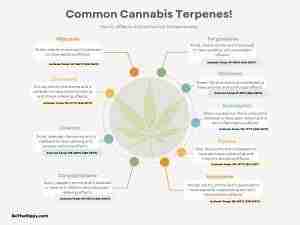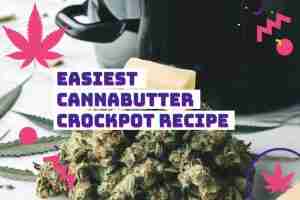Welcome to BeTheHippy’s ultimate guide on how to make cannabutter, the cornerstone of countless delicious and potent edibles!
📝Note: if you are just looking for the recipe and not a deep dive guide, check our simple cannabutter recipe.
Whether you’re a seasoned chef or a curious newcomer in the world of cannabis cooking, mastering cannabutter is a game-changer.
This guide will walk you through each step – from choosing your strain to storing your butter – ensuring you end up with the perfect batch every time.
Plus, I’ll share personal tips and tricks to make your cannabutter journey smooth and enjoyable.
Decarboxylation: The First Essential Step
Have you ever wondered why raw cannabis doesn’t have the same effect as when it’s cooked or smoked?
That’s where the magic of decarboxylation comes in. It’s a fancy term, but its concept is simple: decarboxylation is the process of activating THC or CBD in your cannabis.
Think of it like preheating your oven before baking a cake. If you skip this step, you’re just mixing ingredients without getting that delicious, finished product.
The same goes for making cannabutter – no decarboxylation, no buzz (or at least not a consistent buzz/dosage).
Now, how do you decarboxylate cannabis? It’s easier than it sounds.
First, you’ll need to grind your cannabis. Not too fine, not too chunky, just right – like the Goldilocks of cannabis grinding.
Once it’s ground, spread it evenly on a baking sheet.
Here’s a tip: use parchment paper to avoid sticking.
The key is low and slow. You don’t want to burn your precious buds. I’ve found that setting your oven to 220°-245°F and letting your cannabis gently toast for about 30-40 minutes usually does the trick.
It’s like slow-roasting garlic – it brings out all the flavors and aromas without burning them away. But, and this is crucial, keep an eye on it!
Ovens can be finicky, and you don’t want to turn your first batch of cannabutter into a learning experience on what not to do.
To solve the oven issue, we often use a mason jar and other heating tools to reduce the risk of burning off our cannabinoids.
Once your cannabis has turned a light brown and is fragrant, it’s ready. This is your base for some top-notch cannabutter.
Remember, patience and attention during this stage set the foundation for your cannabis culinary adventures.
📝Learn More About Decarbing
Take a deeper dive on how to decarb for consistent edibles.
Choosing Your Cannabis
Picking the right cannabis strain is akin to selecting the perfect ingredient for a special dish – it defines the entire experience.
Seeking relaxation? An Indica strain might be your choice.
For an uplifting effect, consider a Sativa.
And hybrids? They offer a bit of both, catering to various preferences.
Beyond just Indica and Sativa, the THC and CBD levels are crucial. High THC strains promise a stronger buzz, ideal for those seeking intensity, while higher CBD strains offer therapeutic benefits with less psychoactivity.
It’s all about matching the strain to the desired effect, similar to pairing the right wine with a meal.
Quality is key in cannabis selection. High-quality cannabis is essential for potent, flavorful cannabutter. Think of it as using premium ingredients in cooking; the better the quality, the better the end product.
Invest in the best cannabis you can, as this choice is the foundation of your cannabutter’s success.
In sum, your cannabis selection is the first step in your cannabutter journey, setting the tone for the final product. Choose with care and purpose, and your cannabutter will be all the better for it.
The Infusion Process
The art of making cannabutter starts with choosing your base fat.
Classic butter is a popular choice, but for a twist, why not try coconut oil, olive oil, or any other fat that solidifies at room temperature?
Each brings its own unique flavor and properties, giving your cannabutter its own character.
Now, let’s talk technique. Slow and steady wins the race in the infusion process. Combine your chosen fat with the decarboxylated cannabis in a pot or slow cooker.
The key here is a gentle heat – aim for a temperature of about 160-180°F. This low heat ensures that you extract the maximum potency without risking any burn-off. Let this mixture infuse for 2-3 hours, giving it a stir occasionally.
It’s like steeping a fine tea; patience yields the richest flavors.
Straining Your Cannabutter
After the infusion magic has happened, it’s time to strain your cannabutter, a step that’s as crucial as brewing a fine cup of coffee.
- Lay out your cheesecloth or get a fine mesh strainer ready.
- Gently pour your butter through, capturing all the liquid gold while leaving behind the plant material.
- Squeeze out as much butter as you can, but be careful – like squeezing a tea bag too hard, you don’t want any plant bits in your smooth butter.
Now, what about the leftover cannabis?
While most of the potency is now in your butter, this plant material doesn’t have to go to waste. It can be composted, or if you’re feeling creative, used in other less potent recipes.
Think of it as the parsley of cannabis cooking – not the star, but still has its place.
Storing and Using Your Cannabutter
Storing cannabutter is like keeping a secret stash of gold – you want it safe, secure, and lasting as long as possible.
Your homemade cannabutter deserves the best; store it in an airtight container in the fridge or freezer.
In the fridge, it stays good for several weeks, and in the freezer, you can extend its shelf life even further.
When it comes to using your cannabutter, the world is your edible oyster. It’s a one-to-one swap for regular butter in any recipe.
Dreaming of gooey chocolate chip cookies or fudgy brownies? Just replace the regular butter with your cannabutter.
Be sure to check out our recipes for Cannabutter Chocolate Chip Cookies and Cannabutter Brownies for some scrumptious ideas!
Dosage and Safety Tips
Calculating the dosage of your cannabutter can feel like being a mad scientist, but it’s simpler than you think.
And we have a free dosage calculator to help out if you are worried.
A solid starting point is knowing the potency of the cannabis you used. From there, you can estimate the overall potency of your butter.
But remember, when it comes to edibles, it’s always best to start low and go slow.
If you’re new to the world of edibles, begin with a small amount. It can take a couple of hours to feel the full effects, so patience is key.
The last thing you want is to overindulge too soon and find yourself on a more intense journey than expected.
Troubleshooting Common Cannabutter Issues
Even the most seasoned cannabis chefs can run into a little trouble now and then. Let’s troubleshoot a couple of common cannabutter issues, so you’re prepared for anything.
- Burnt Butter: If you find your butter taking on a scorched taste or smell, the heat was likely too high. Cannabutter is a patience game. Low and slow is the mantra. If you burn your first batch, don’t be discouraged. Adjust the temperature down a bit next time, and remember, every mistake is a step towards perfecting your craft.
- Weak Potency: Not getting the kick you expected? This could be due to a couple of things. Maybe your cannabis wasn’t decarboxylated long enough, or the infusion time was too short. Next time, ensure your decarboxylation process is on point, and let your mixture infuse for the full recommended time. Sometimes, it’s just about fine-tuning the details.
WooHoo!
Congratulations on embarking on your homemade cannabutter journey!
By now, you should feel confident in your ability to create this essential ingredient that transforms ordinary recipes into extraordinary cannabis culinary creations. Remember, making cannabutter is both a science and an art – it takes practice, patience, and a bit of experimentation.
Embrace each step, have fun with it, and relish in the delicious outcomes.
Now that you’re armed with the knowledge and skills, what’s next on your cooking agenda? I’d love to hear about your cannabutter adventures and the tasty treats you create!
Share your stories, recipes, and experiences in the comments below – let’s keep the cannabis culinary conversation going. And if you’re hungry for more tips, tricks, and recipes, don’t forget to subscribe to BeTheHippy.
Happy cooking, and here’s to many delightful dishes infused with your very own cannabutter!







